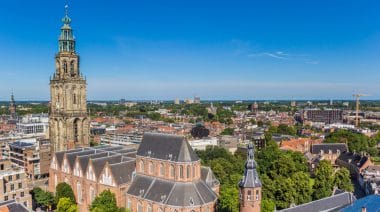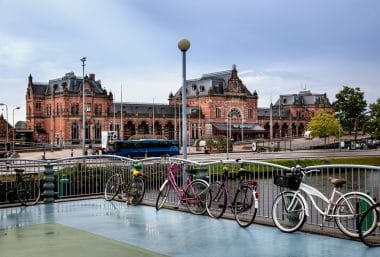In the northeast of the Netherlands lies the authentic, often misunderstood idyll of Groningen, capital of the province of the same name and a time-honored educational location. The regional metropolis, which has a population of around 230,000, is criss-crossed by canals and connected by waterway to the Ems coast of the North Sea. About 70 kilometers to the east is the border with the Federal Republic of Germany with the cities of Leer and Papenburg. Amsterdam is about 180 kilometers to the southwest. The special geographical location helped Groningen to grow and prosperous. Today, the remarkable city is not only popular with the many students, but also leaves a lasting impression on numerous travelers.
Medieval centre
The first roots of a settlement in Groningen date back to 300 years BC. In the 7th century, the foundation stone for the urban core area was laid around the “Grote Markt”, the central large market square of the old town. Several archaeological investigations confirmed these findings. The first documentary mention dates back to the year 1040. It testifies to a donation by the then King Henry, who signed over the place to the Bishop of Utrecht , whereby the city was also granted the sovereign right of customs and mint.
As a result, Groningen developed into a trading and goods trading centre. The connections to England and the Baltic Sea countries prompted many merchants to settle in the city. As a later member of the Hanseatic League, a local jurisdiction and the creation of an urban infrastructure, Groningen became one of the pearls of the Dutch heyday.

A touch of this era can still be felt today at the market in the old town. Immediately adjacent to it, the Martinikirche rises into the sky. Groningen’s oldest and tallest church was built between 1469 and 1482 from light brown-red sandstone. Its mighty tower once stood 127 meters before the wooden spire had to be replaced due to a fire. Another highlight of the Martinikirche is the organ built in 1692 by the famous Hamburg organ builder Arp Schnitger. At the fish market, the Aa Church is another sacred building.
The church building at the Akerkhof was built in the 15th century and also received a Schnitger organ in 1702. On the market side, the silhouette is complemented by the imposing columned building of the grain exchange, a UNESCO monument. Nearby, the Groningen town hall from 1810 shines in a similar construction. The inner-city area is surrounded by an extensive canal system, on the flanks of which the old warehouses can be admired.
Between tradition and modernity
Groningen offers travellers a real alternative to Amsterdam. The pulsating multicultural life constantly changes between tradition and modernity. The markets, shops and restaurants meet all the requirements of a versatile, urban way of life. Only on Monday mornings should you not be surprised about the emptiness in the pedestrian zones, because here the Dutch take it rather contemplative and, like in many other cities, extend the weekend.
Large parts of the city belong to cyclists. This circumstance is particularly noticeable in the area of the university, where thousands and thousands of two-wheelers almost flood the squares in front of it. Groningen has been committed to education since 1614 and has a university. The impressive main building for the approximately 50,000 students enrolled today dates back to 1909. Despite the sometimes hectic hustle and bustle, there are many places of tranquillity and relaxation in Groningen. These include, for example, the hidden small courtyards in the busy centre. In earlier times, these “Hofjes” offered accommodation for the poor or sick and are now admirable oases of reflection.
In order to discover the small farm grounds, visitors sometimes have to take a closer look. Or you can explore the special features of Groningen’s historical remnants in the form of an extremely interesting city tour. Behind walls lies the Prisenhof, another refuge of silence in the middle of the centre. The former seat of the Princes of Nassau has existed since the end of the 16th century and is landscaped with an enchanting rose and herb garden.

Small paths lined with hedges and trees are one of the most beautiful examples of a hardly comparable Renaissance complex of this kind in the whole of the Netherlands. A little north of the city centre is the beautiful green area “Noorderplantsoen”, covered with small lakes. The water-rich park was created on a landscape created by glaciers, which was once the scene of historical battles and is now considered the leisure idyll of the people of Groningen, which is also the venue for many events.
Varied adventure programme
It is especially the diverse impressions and the contrasting versatility that make a lasting impression on the overall urban image of Groningen in the memories of visitors. In the new “Forum Groningen” there is such an aspect. The futuristic building complex is a meeting place for all generations, houses the “Storyworld Museum”, the library, several cinema halls, the “Smartlab”, a technology and workshop facility for children, but also for adults, as well as a number of restaurants. From the roof terrace, guests are rewarded with one of the most beautiful views over the whole of Groningen.
Close to the Central Station, whose historic hall is already a real sight, is the Groninger Museum. Built in 1994 under the aspect of a modern architectural orientation, the building’s perspective has provided space for controversial discussions since its opening. However, the interior design and the always sensational exhibitions make a visit an experience.
Groningen offers its visitors plenty of space for leisure activities of all kinds. Above all, the proximity to the Wadden Sea and the North Sea is appreciated. Travellers should definitely plan the Lauwersmeer National Park area in the northwest of the city as a destination. The area, which was diked in 1969, became one of the most beautiful nature reserves in the Netherlands over the course of the following years. Extensive hikes, bike or boat tours with observations of the unique flora and fauna are particularly popular with families with children. A little further inland, travellers can get an idea of how the locals of the region resisted the floods of the North Sea. The terp village of Niehove, built in a circle on hills, is an example of what was done to wrest a piece of land from the water. In the east of Groningen, on the border with Germany , lies the Bourtange fortress, which William of Orange had built at the end of the 16th century and which is now used as an extraordinary living space.


